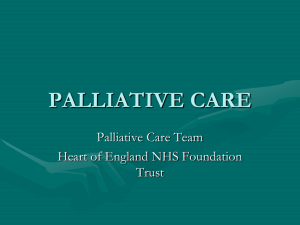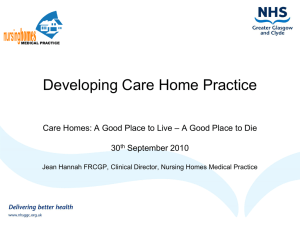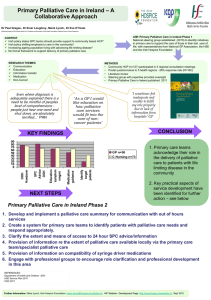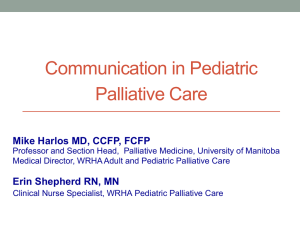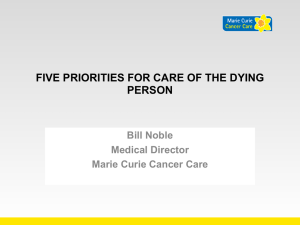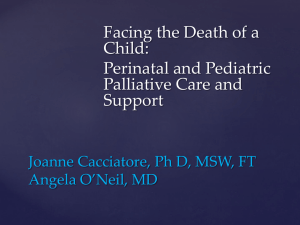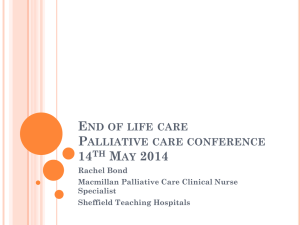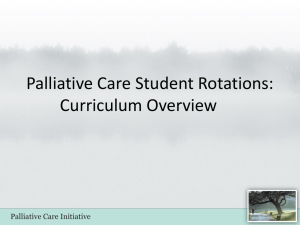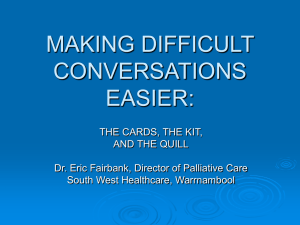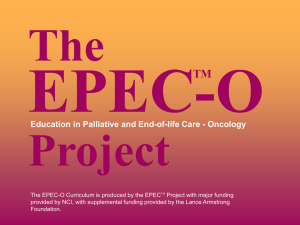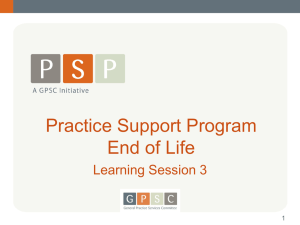National Overview - Cheshire & Merseyside Strategic Clinical
advertisement
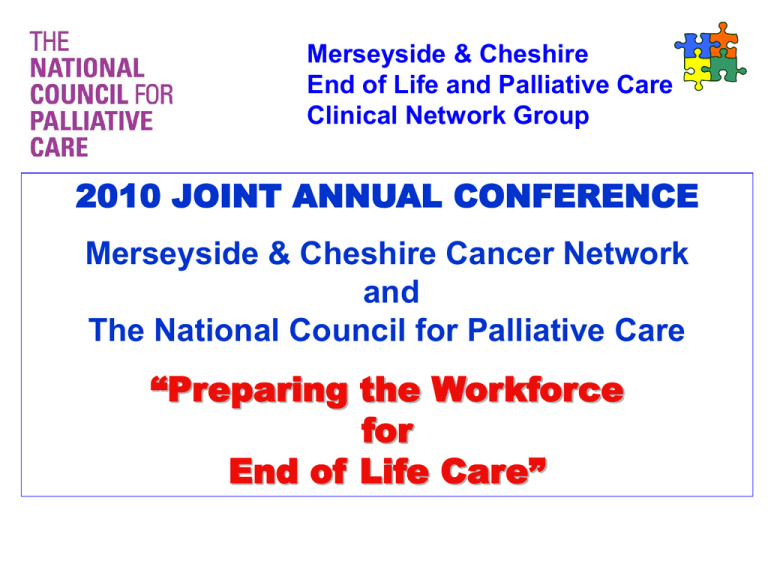
Merseyside & Cheshire End of Life and Palliative Care Clinical Network Group 2010 JOINT ANNUAL CONFERENCE Merseyside & Cheshire Cancer Network and The National Council for Palliative Care “Preparing the Workforce for End of Life Care” Merseyside & Cheshire End of Life and Palliative Care Clinical Network Group WELCOME AND INTRODUCTION TO THE DAY JULIE GORRY (Chief Executive, St John’s Hospice Wirral NCPC NW Area Representative) National Overview Professor John Ellershaw National Deputy End of Life Care Lead, Department of Health Director, MCPCIL Achieving excellence in end of life care: Overview • Where have we come from on end of life care? • Key aspects of the End of Life Care Strategy • Early progress on implementation • Next steps National initiatives on end of life care 2000 NHS Cancer Plan - £50m pa for specialist palliative care services 2004 NICE guidance on supportive and palliative care (adults with cancer) 2004-7 National End of Life Care Programme (£4m x 3 years) - part of the ‘choice’ programme - roll out of GSF, LCP, PPC etc. by 28 SHAs 2005 Labour election manifesto commitment to increase choice at the end of life and double investment in palliative care 2006 Decision to develop a national strategy 2007/8 SHA ‘Darzi’ EOLC workstreams 2008 End of Life Care Strategy End of Life Care Strategy Aims: • To bring about a step change in quality of care for people approaching the end of life • To enhance choice at the end of life • To deliver the government’s manifesto commitment to double investment in palliative care End of Life Care Strategy Key elements: • Societal level: • Individual level: Integrated service delivery based around a care pathway • Infrastructure: Actions to raise awareness of death and dying and to change attitudes Workforce development, measurement, research, funding, national support etc. Examples of SHA priority areas NW: Aim for 10% reduction in hospital deaths NE: 10 priority Quality Markers Public health approach – Charter on EOLC Y&H: Social marketing work SC: DNAR policy EOE: Marie Curie Delivering Choice Programme SW: EOLC registers National support for implementation • Coordination between SHAs e.g. DH + SHA clinical/managerial leads • Further policy initiatives DH End of Life Care Policy Team (Tessa Ing) • Support for the NHS, social care and third sector National End of Life Care Programme (Claire Henry) • Deputy National Clinical Directors Professor John Ellershaw and Dr Teresa Tate Death, dying and society • National Council for Palliative Care is running the national coalition Dying Matters • Around 7000 members – hospices, schools, solicitors, the GMC • NatCen Survey, to set baseline for current awareness and attitudes • Literature review (Professor Jane Seymour) • Awareness week: March 2010 National End of Life Care Programme workstreams Pre pathway Step 1 Discussions as the end of life approaches Raising Awareness • Supporting NCPC Commissioned literature review National Coalition Dying Matters • Member of Dying Matters • National Awareness raising week • Communications skills (introductory, intermediate, advanced) 12 pilots • Clinical triggers kidney, dementia Heart cancer neurological • Transition services from children to adult services Step 2 Step 3 Assessment, care planning and review Coordination of care • Advance care planning - patient and professional information – planning for your future care (evaluation) • PPC • ADRT information for patients • Assessment framework/ pilot (EoE) • Locality wide registers pilots (8 sites) • DH initiatives Transforming community services integrated care pilots Personal budgets Step 4 Step 5 & 6 Delivery of high quality services in different settings Care in the last days of life and care after death • Acute Hospitals • Primary care – GSF/ADA • “Route to Success” • Care homes (volunteers) • Extra care housing • Prisons • Hostels • QIPP • LCP neurological /hospital Audit • Environments of care - King’s Fund • Last offices • Bereavement Social care Measurement - Intelligence network ,quality markers , VOICES Spirituality, User involvement, Information/support for patients and carers Workforce – competences, E-learning, methods of delivery, facilitators network Commissioning, currency and pricing, provider development, service improvement Cross boundary working/sharing good practice, communications strategy, events ,website Step 1: Identifying people who are approaching the end of life Step 2: Assessment and care planning • Advance care Planning: A guide for health and social care staff • Planning for Your Future Care Step 3: Coordination of care Locality registers: 8 pilots • Camden PCT Provider Services • Royal Marsden NHS Trusts and Connecting for Health • Sandwell PCT • Salford PCT with Salford Royal NHS Foundation Trust • Weston Area Health Trust • NHS Brighton and Hove • Leeds Teaching Hospital • NHS Mid Essex London: Hospital to Home project with IT support Integrated OOHs Care Integrated Service Model (16.00-9.00 Mon-Fri; and 24hr cover weekends) Triage calls Patients, Family Provide advice Provide crisis hands on care Core team in Community Coordination Centre •Arrange packages of care for community professionals and discharge •End of life Register •Information and sign posting for services Supportive Care Pathway Role-key worker • To direct and manage the care; GSF Register; care plan; MDT practice meetings Advanced care plans Integrated Hospital Discharge Team Case manager OT, ward nurse, social care worker •Website for palliative care •Coordination of training and education •Management information Short notice planned care, planned care (health & social care providers) Professionals Commissioners (arranging and managing contracts) Step 4: Delivering high quality services THE ROUTE TO SUCCESS IN END OF LIFE CARE - ACHIEVING QUALITY IN ACUTE HOSPITALS Step 5: Care in the last days of life • Vast majority of clinicians believe that care of the dying has improved as a result of LCP • Of course, LCP must be used properly Training Assessment that a patient is likely to be dying Documentation Review Audit • 155 hospitals participated in the 2nd national audit Step 6: Care after death • NCDAH shows poor data returns • After Death Audit (for the Gold Standards Framework) • Bereavement is to be a new strand of work for the End of Life Care Policy Team Workforce development • Progress from SHA EoLC Workforce Leads using MPET funding • E-learning for healthcare – modules launched 21 January – free access for health and social care staff • Pilots to review communications skill needs and provision at basic, intermediate and advanced level, to report December 2010 Measurement • Place of death (from death certification) • National End of Life Care Intelligence Network will bring together different datasets e.g. HES, ONS, GPRD and social care • VOICES – surveys of bereaved relatives will provide a proxy for quality of care given to patients at the end of life • Other measures are being considered Next steps • The Coalition: our programme for government (May 2010) “We will provide £10 million a year beyond 2011 from within the budget of the Department of Health to support children’s hospices in their vital work. And so that proper support for the most sick children and adults can continue in the setting of their choice, we will introduce a new per-patient funding system for all hospices and providers of palliative care.” Summary • We are now approaching two years since the publication of the End of Life Care Strategy • Momentum continues to increase (National, Third Sector, SHAs and some PCTs) • It is still too early to assess outputs/outcomes • The financial climate is very challenging Summary • We are now approaching two years since the publication of the End of Life Care Strategy • Momentum continues to increase (National, Third Sector, SHAs and some PCTs) • It is still too early to assess outputs/outcomes • The financial climate is very challenging • Opportunity – to make a difference SETTING THE SCENE Eve Richardson Chief Executive www.ncpc.org.uk ABOUT NCPC • The umbrella charity for palliative care • Promotes palliative care for all • Influences government policy • Supports all sectors involved in providing, commissioning and using palliative and end of life care services • Provides guidance on best practice (combining evidence with experience) www.ncpc.org.uk 5 DH PRIORITIES • A patient-led service culture - “nothing about us without us” • Focus on better health outcomes - aligning patientreported experiences with clinical outcomes • Autonomy and accountability - empowering clinicians free from target-centred and bureaucratic systems • Improving public health - promoting health, well-being and individual responsibility as part of the Big Society • Reform of long term care - with better integration of health and social care www.ncpc.org.uk 3 CHALLENGES FOR THIS PARLIAMENT • “Ensuring a good death for everyone” should be a key quality outcome for all commissioners and providers across health and social care • Access to co-ordinated 24/7 end of life care services to enable people to remain in home and community settings of their choice • Empowering people to talk about dying, death and bereavement and to make plans for their the end of life care and support www.ncpc.org.uk Merseyside & Cheshire End of Life and Palliative Care Clinical Network Group DISCUSSION
